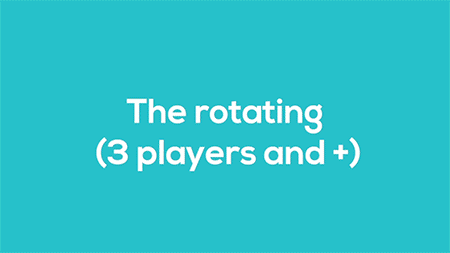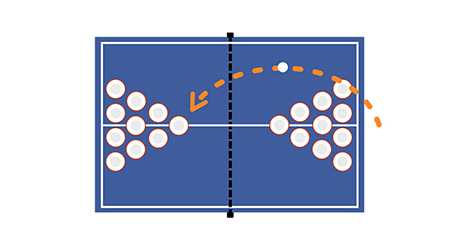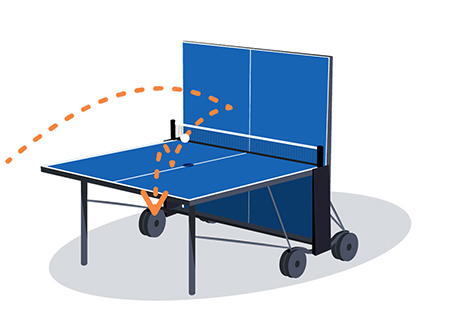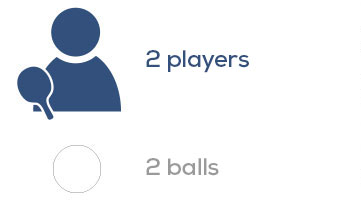Ping-pong is such a versatile and adaptable sport that it can be played in so many different ways. While a traditional and competitive game is a standard way to play, families can also have fun by setting up a version for kids. There really is something for everyone! Ping-pong can be explored and reinvented at every level of the game. So how do you link family fun with a competitive sporting activity? And which game formats suit you?
What are the different game formats in ping-pong?
What are the different game formats in ping-pong?
THE TRADITIONAL PING-PONG GAME

For two to four players, what could be more enjoyable than a game of ping-pong? For beginners, amateurs, or professionals, this versatile game format appeals to everyone. To play it undercover, opt for an indoor table, which can be adapted to the space available. Outdoor ping-pong tables are a lot more solid and hard-wearing and are geared up for dynamic play. Professionals can count on competition tables as a guarantee of sturdiness and stability.
The rules of the game
The first step consists of keeping a firm grip of your bat. Very popular in Asia, the penholder grip enables you to hold the handle of your bat in the same way as you would a pen. Meanwhile, the classic ‘European’ grip sees the player wrap the three lower fingers around the handle and grip the paddle with the thumb on one side and the index finger on the other. Opt for the grip that feels most comfortable for you. In any case, make sure that your wrist is as mobile as possible. Your hand must be relaxed and loose to give your movements greater strength and precision. Once you’re holding your bat, decide which person will be first to serve. You can choose between playing singles or doubles. In the first instance, you can hit the ball anywhere on the other side of the net.

If you’re playing doubles, the first server is decided by the team, which has won the service and the opposing team then decides on the receiver. The server must serve into the right diagonal, which means that the ball must first bounce in the server’s right-hand half of the table then on the receiver’s right-hand half of the table. Next, each player must hit the ball in turn. The change of server then adopts the following sequence: the receiver becomes the server, and the server’s partner becomes the receiver, and so on…

Continue your exchanges as many times as necessary, and above all, have fun! If you play a match, remember that the winner of a set is the person who wins the first three games. A game is won at 11 points. Additionally, the winner needs to gain at least a 2-point lead over the opposing team.
ROTATING PING-PONG

Rotating ping-pong requires a minimum of three players. The players respectively position themselves on either side of the table. The side with more players is the first to serve. The principle of the game is to hit the ball whilst circling around the table. When a player misses a ball, the latter lays his or her bat on the table. If a player still in the game bounces the ball on the bat, the eliminated player can rejoin the game. Once there are no more than two players, they get involved in a match to decide the winner.

BEER PONG: EVENING PING-PONG

Beer Pong is another game option found popular among students and young adults. The idea is to throw a ping-pong ball into a plastic cup filled with drink, which your opponents then have to down. Essentially, each time the ball lands inside the cup, the opposing team has to drink its contents. The cups are positioned in a triangle on both sides of the ping-pong table and must be touching. The player designated to shoot keeps his or her elbow behind the edge of the table. It’s possible to replace the cups at any point in the game. All you have to do is position the cups where they would have been if they hadn’t slipped over. The team which manages to reach all the opposing team’s cups wins the game. Opt for an outdoor ping-pong table, which is much more hard-wearing and suited to such ‘boozy’ leisure pursuits.

SOLITAIRE PING PONG

Ping-pong can be played by a single player, even though it can be much more fun to play with real partners. As a result, a person on their own can also reap the physical and mental benefits of this activity. All our tables are designed to favor individual practice. They have the ability for one half of the tabletop to be folded up vertically. In its raised position, the tabletop provides an opportunity for the single player to train by making the ball bounce back onto a flat, raised surface. The advantage of this form of practice is that a single player can get in some training whatever their level. In this way, the player can adapt to speed and movements according to their preferences.

FUN GAME FORMATS FOR KIDS
Hitting ping pong balls back and forth for a long period can grow tiresome for kids. To keep them engaged, why not introduce new game formats? There are a variety of really fun exercises to help develop the child’s dexterity to handle his or her bat!
The hoop game

The hoop game is entertainment at its finest. To begin with, place five hoops at different distances apart. The first hoop corresponds with the shooting area. The aim is to hit the ball from the shooting area into the second hoop, then into the third and so on till the last. While both entertaining and fun, this game helps improve a player’s concentration and precision.

Ball ping

The multi-ball game is ideal for older or more experienced children. Each player holds a ball. The designated player counts to three, then the two players serve at the same time and work together to keep both balls going back and forth for as long as possible. This constant exchange promotes a sense of cooperation. Once there is just one ball in play, the two players become adversaries and battle it out till victory is achieved. The practice of ping-pong knows no bounds. Discover, try out, and adopt the game options you find most interesting!




